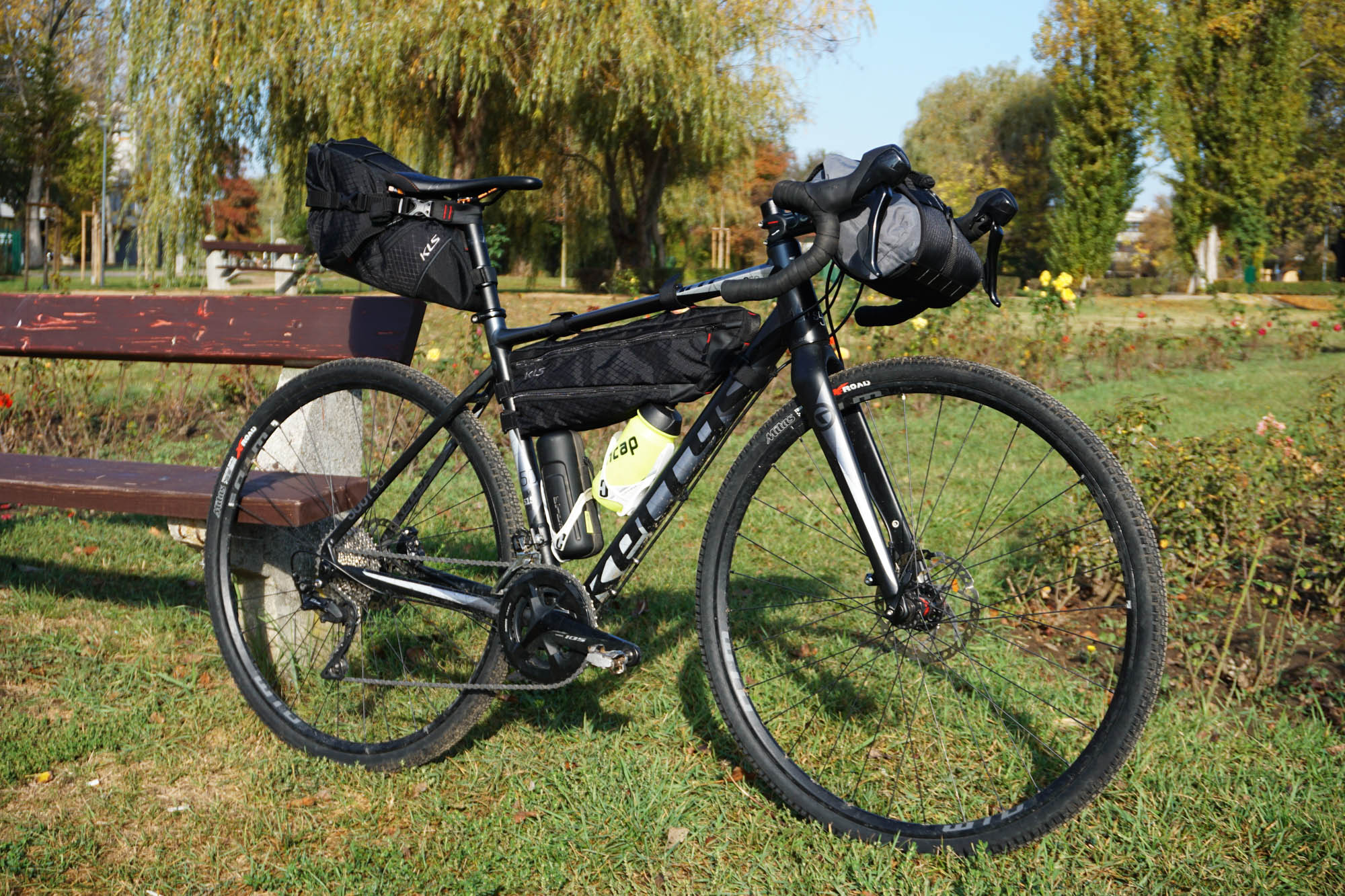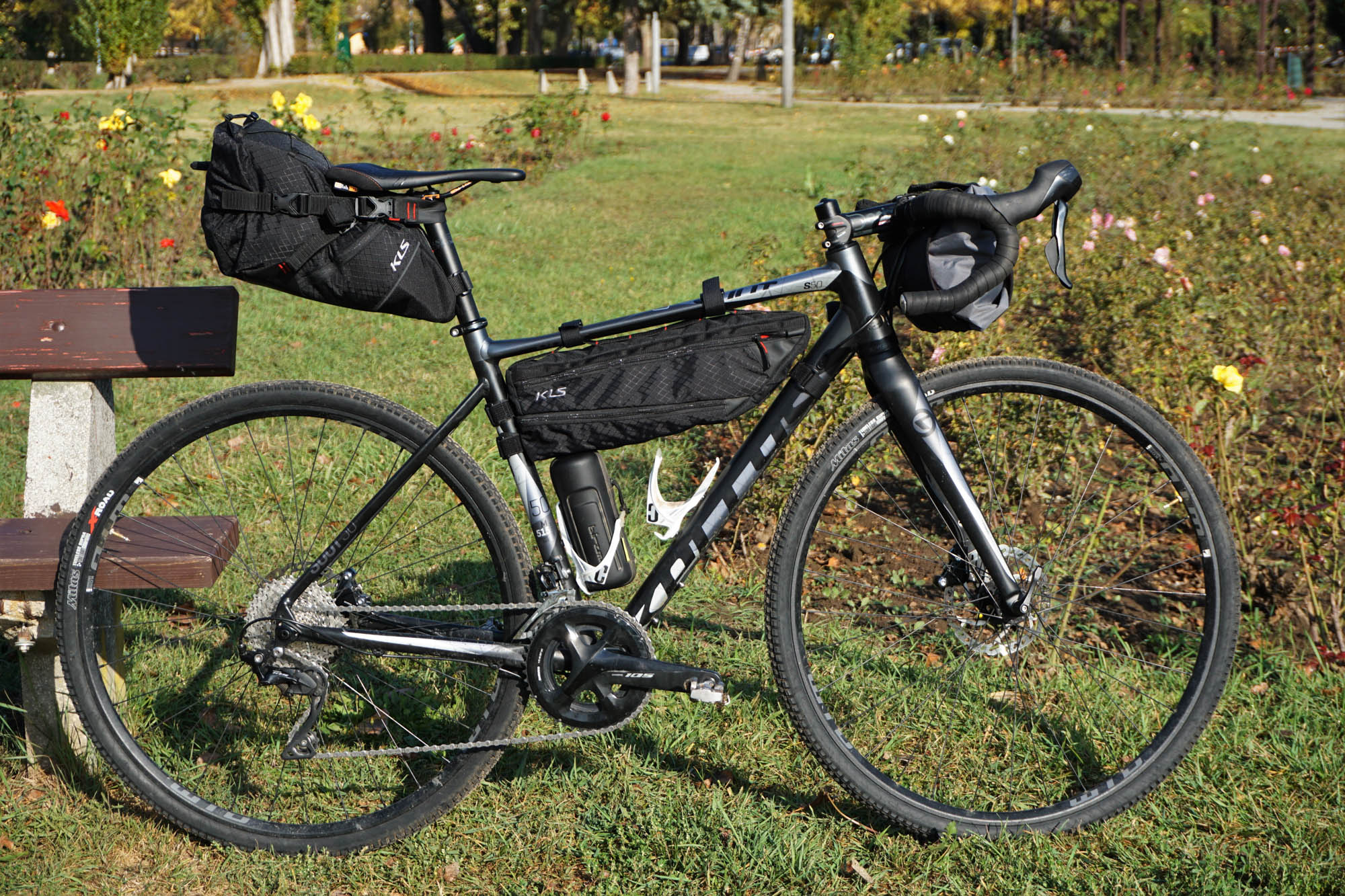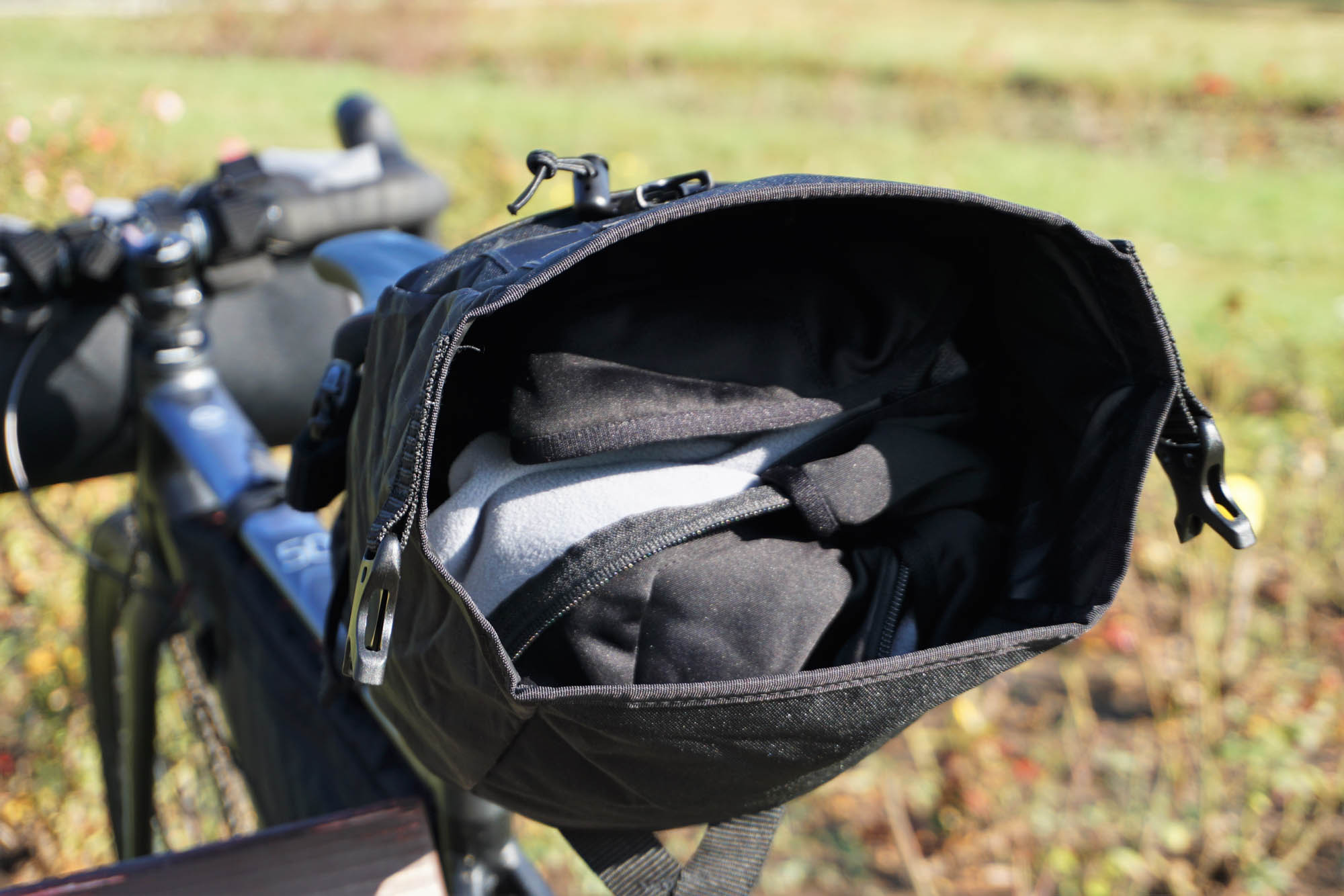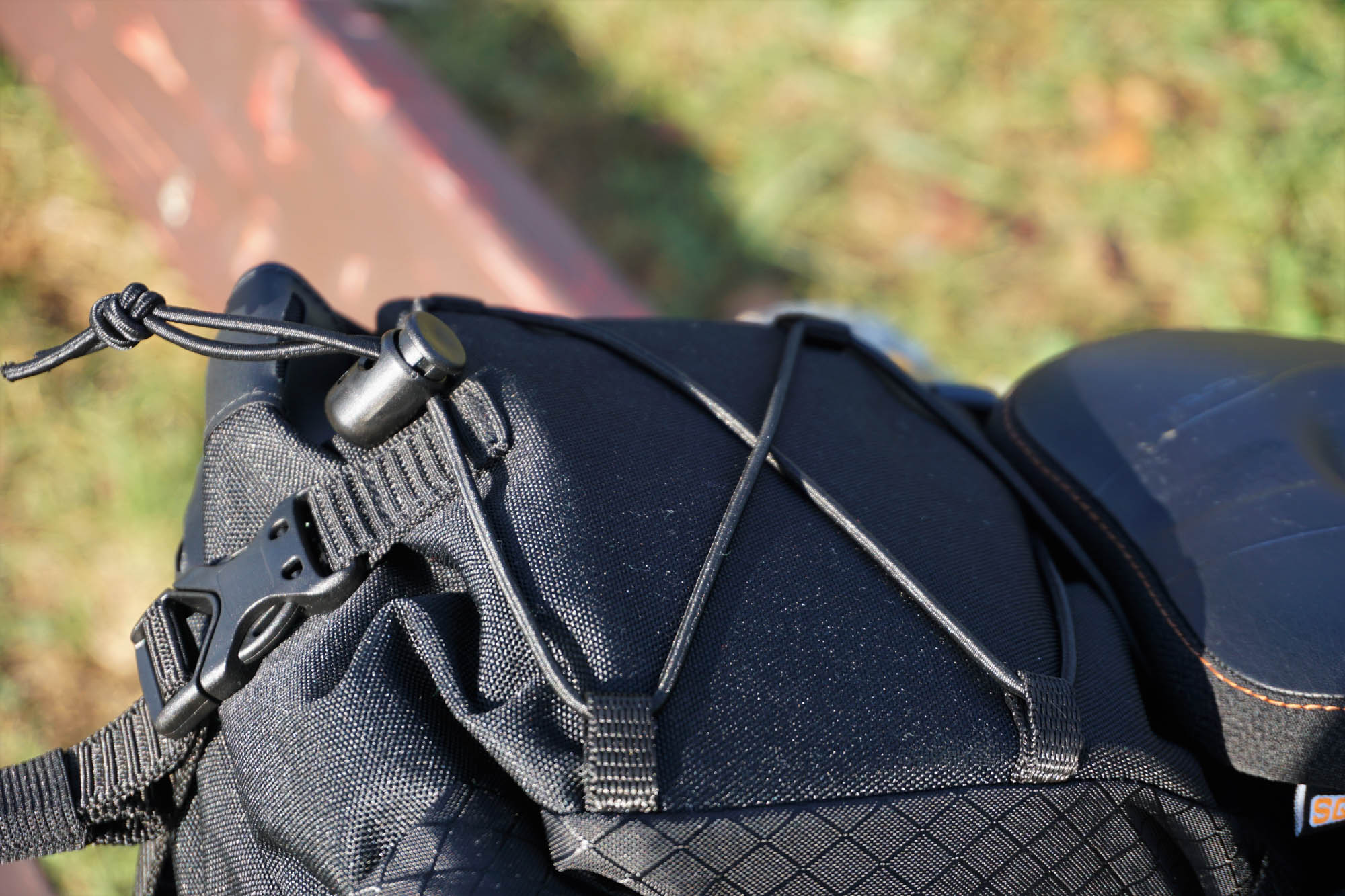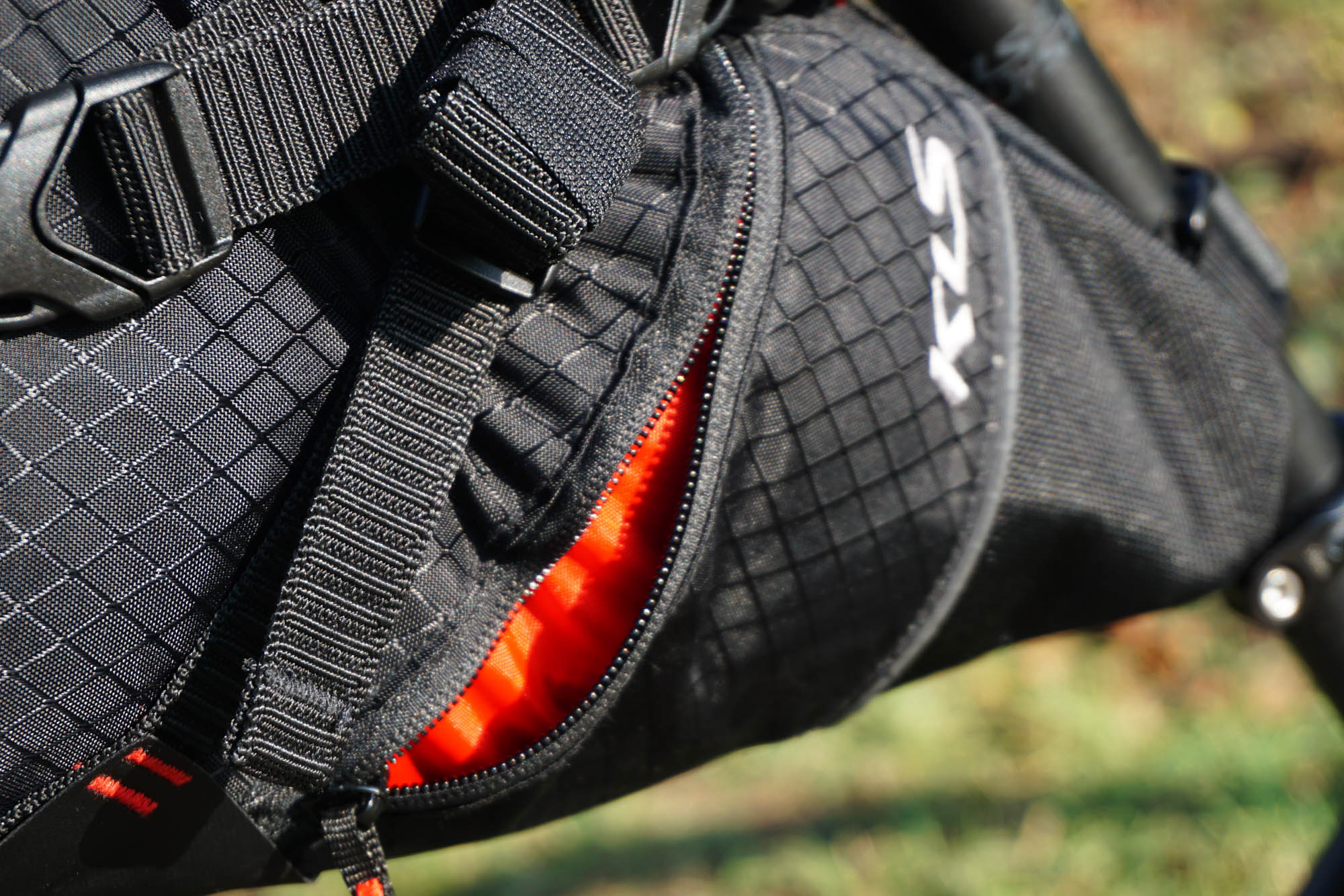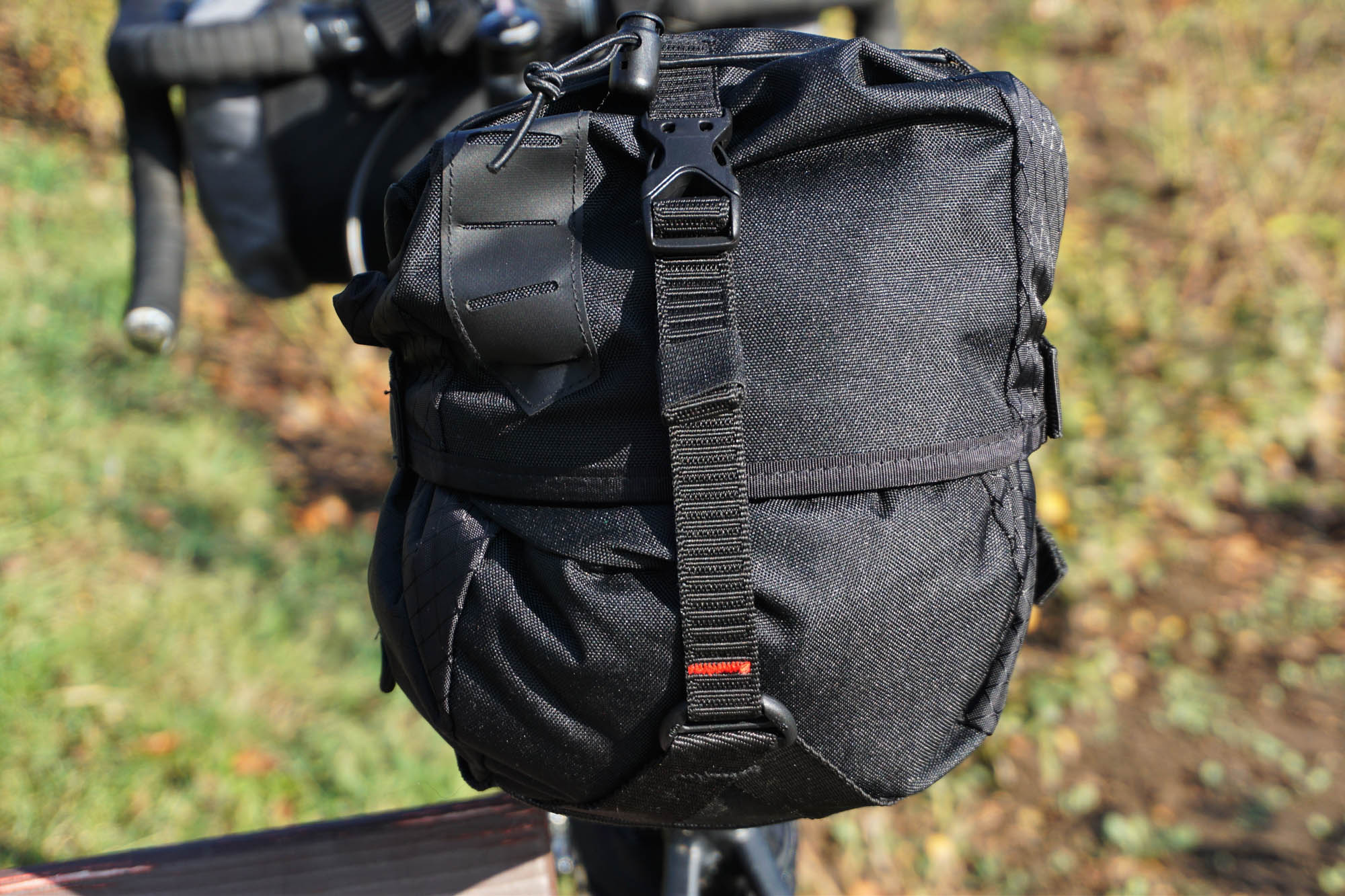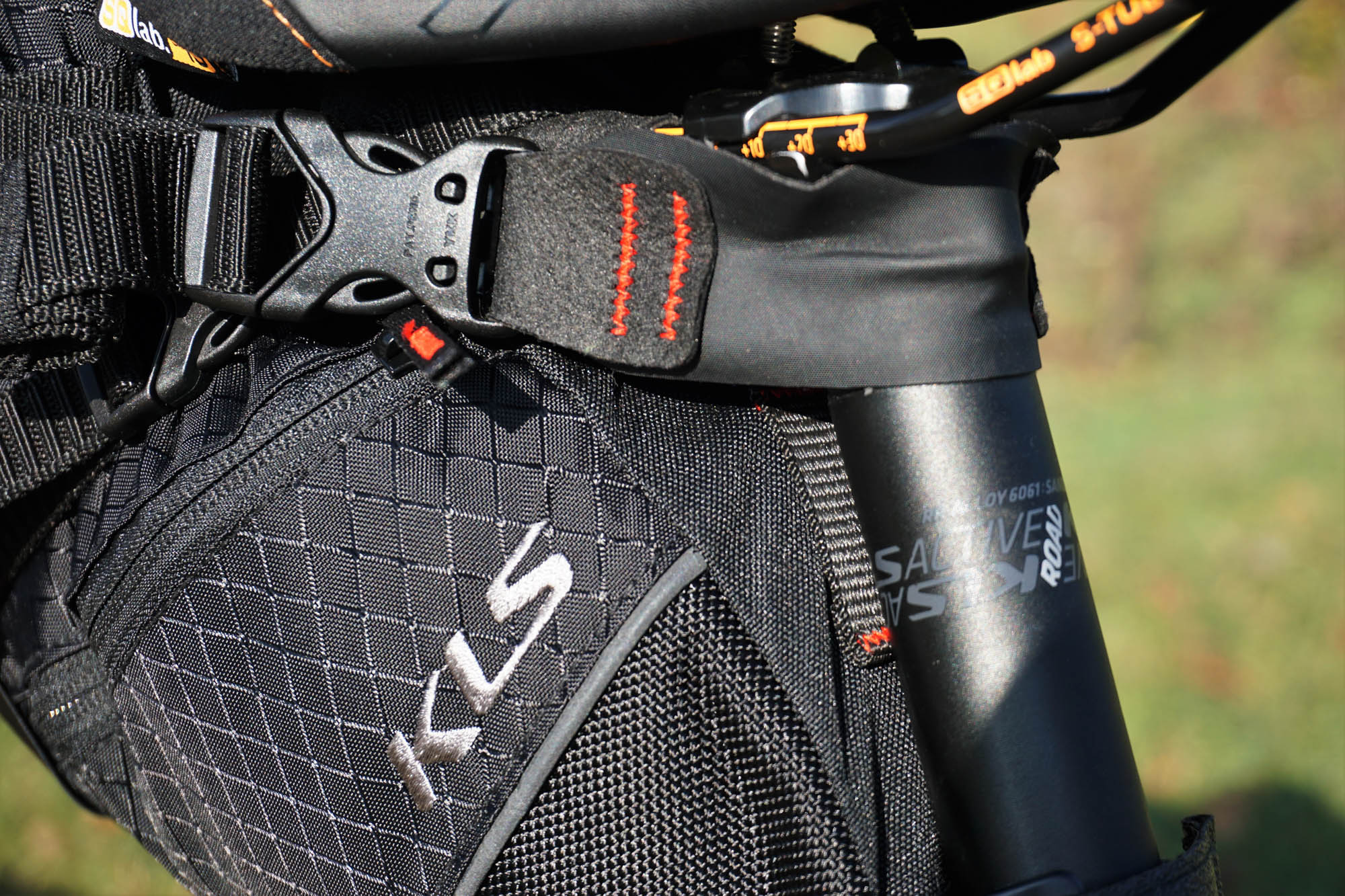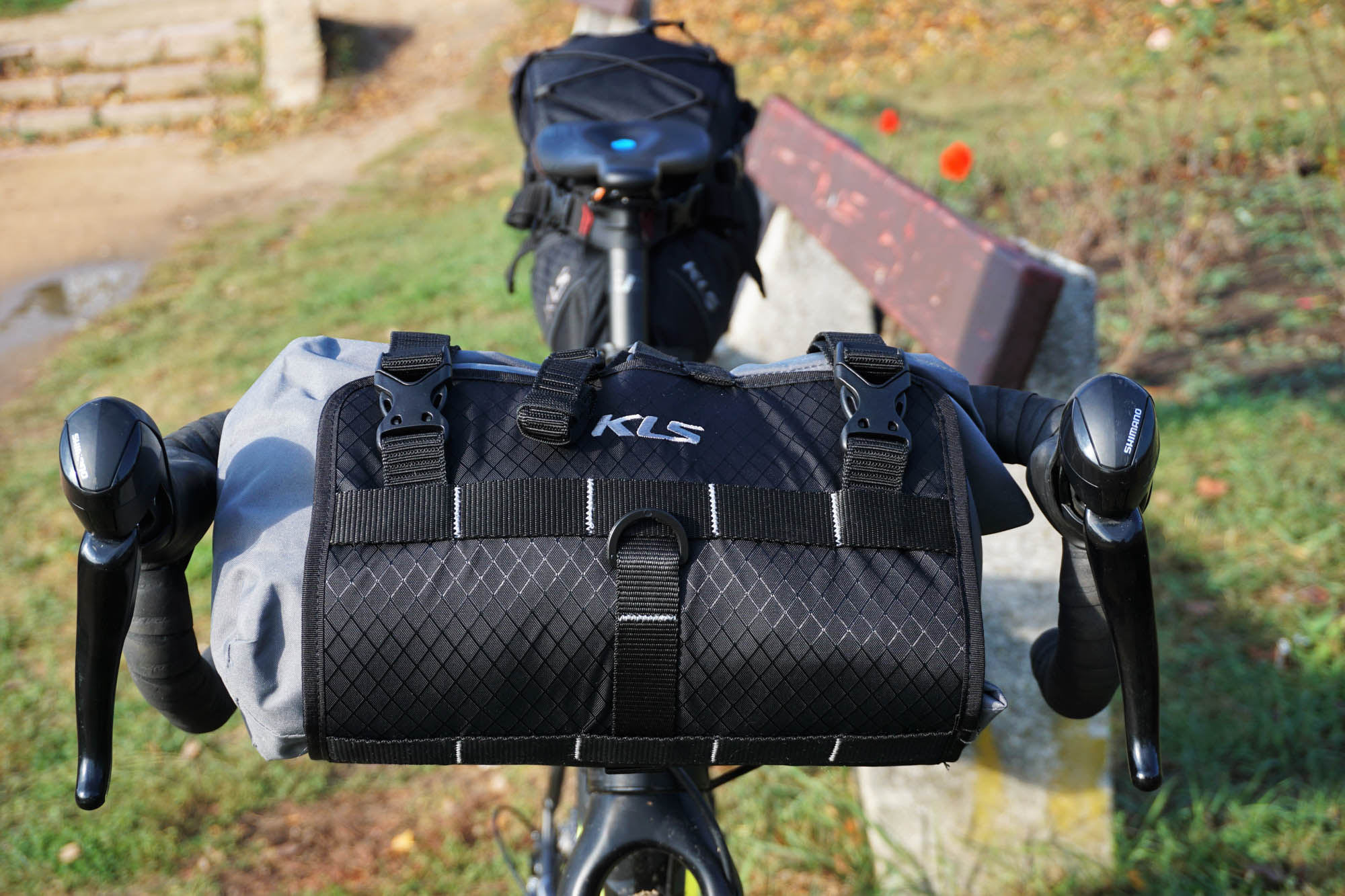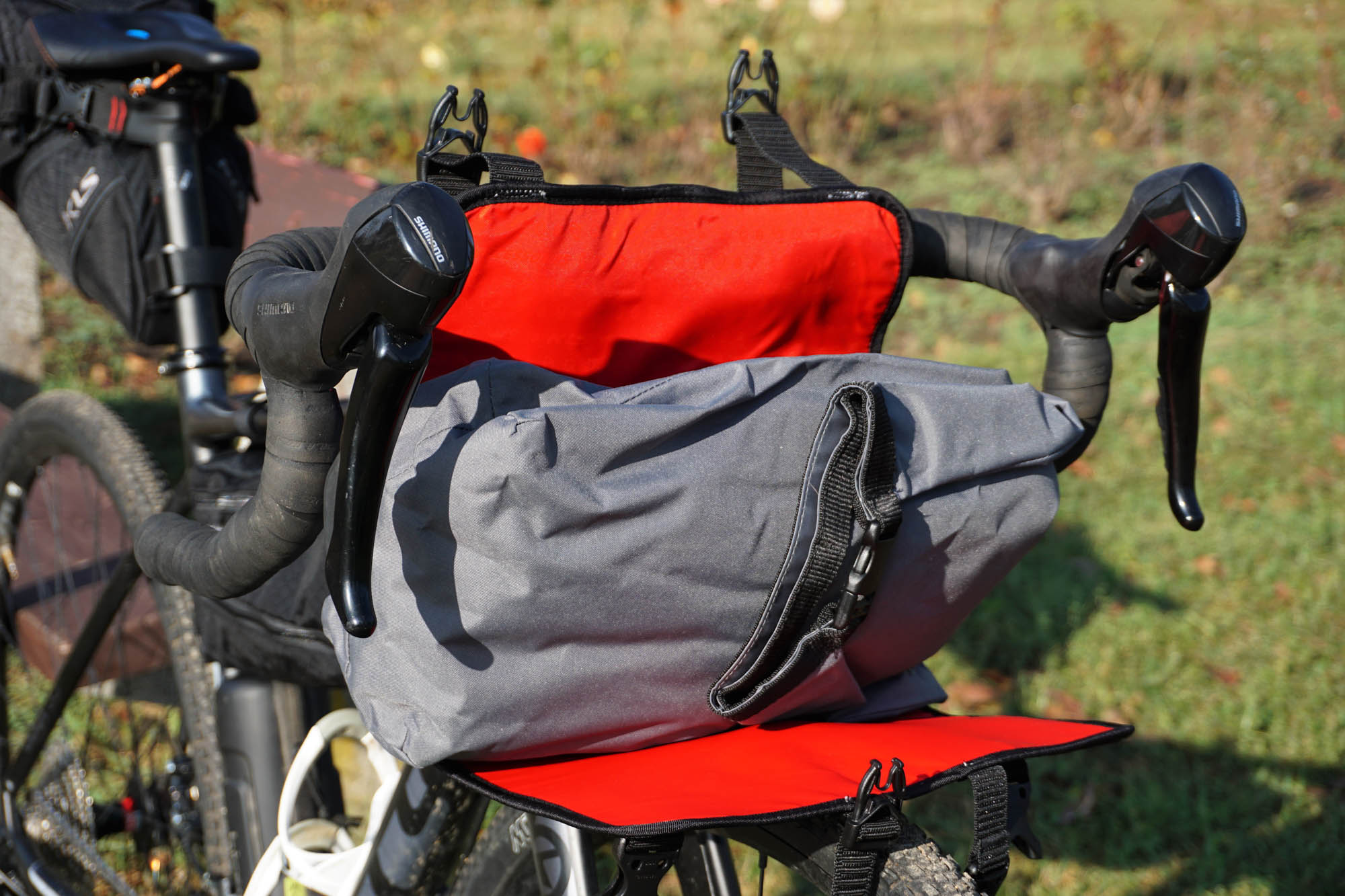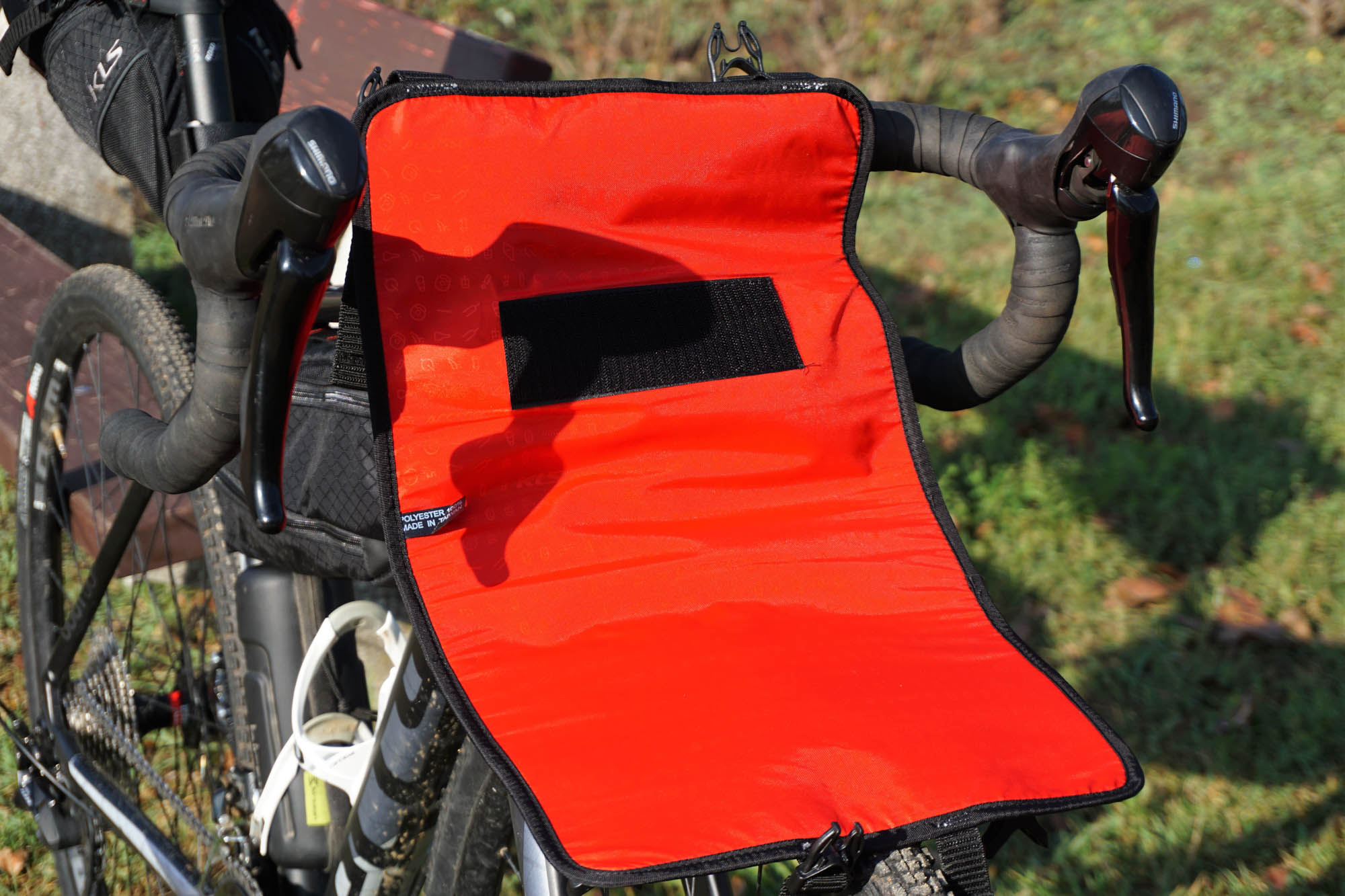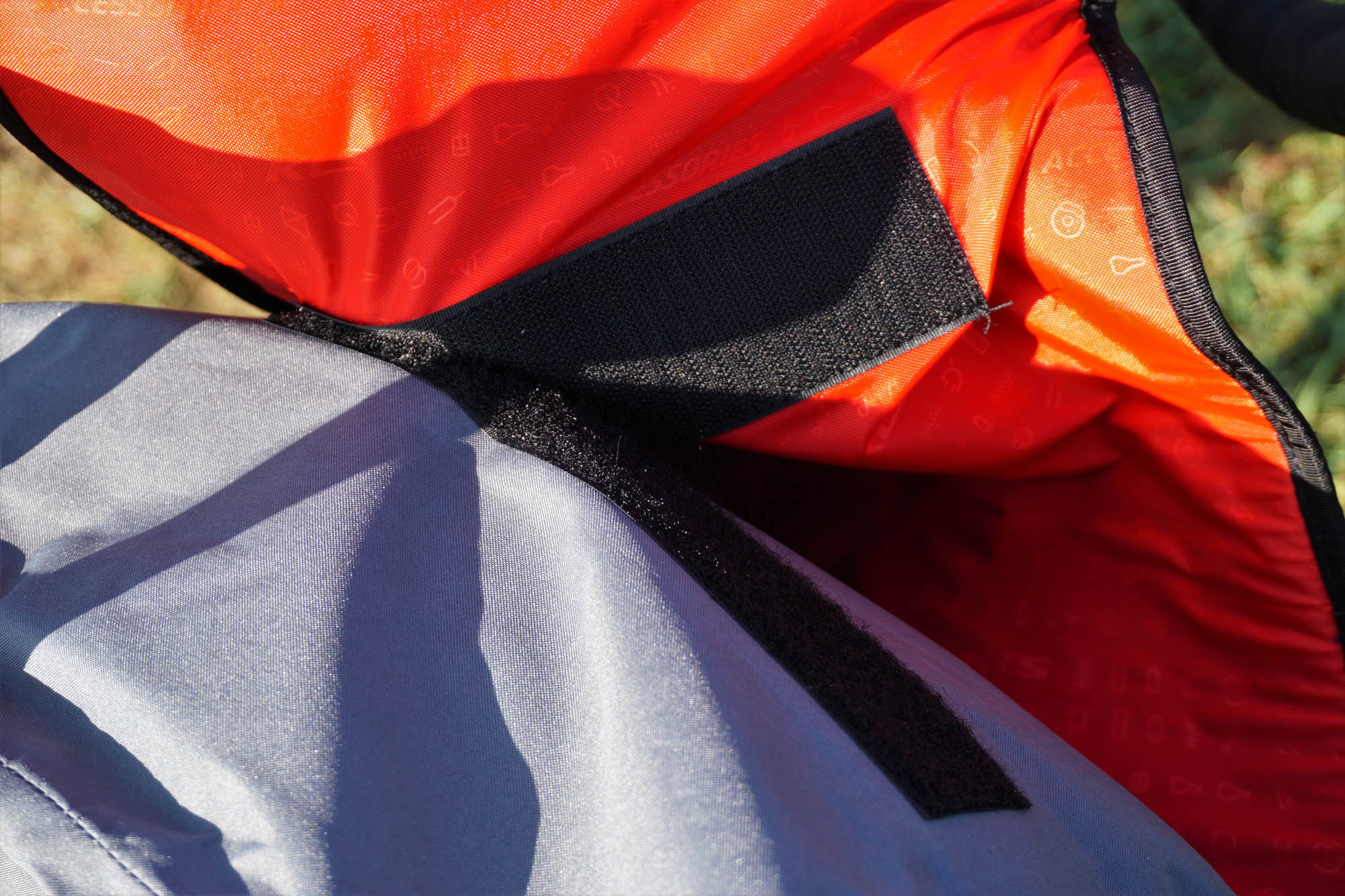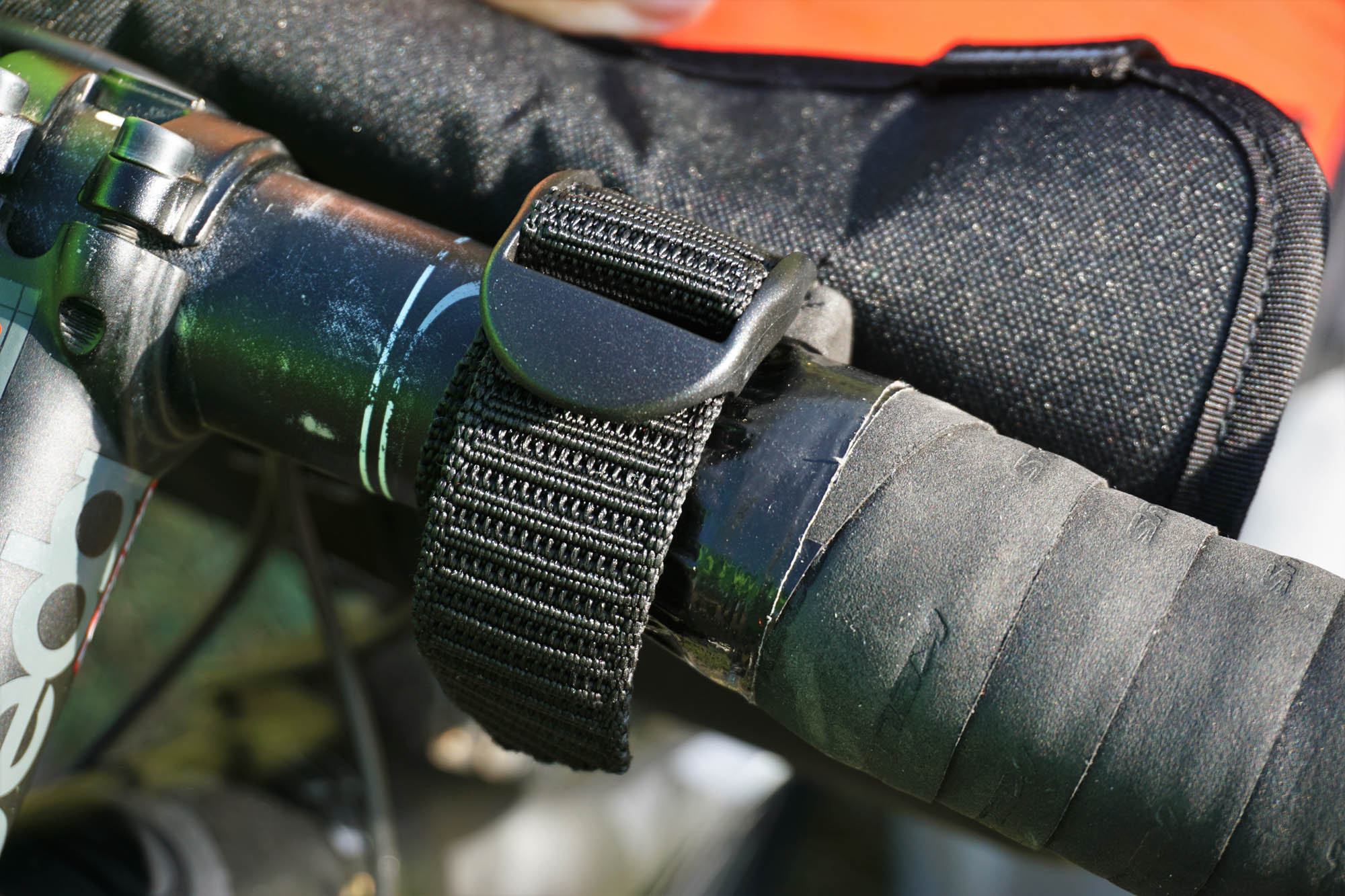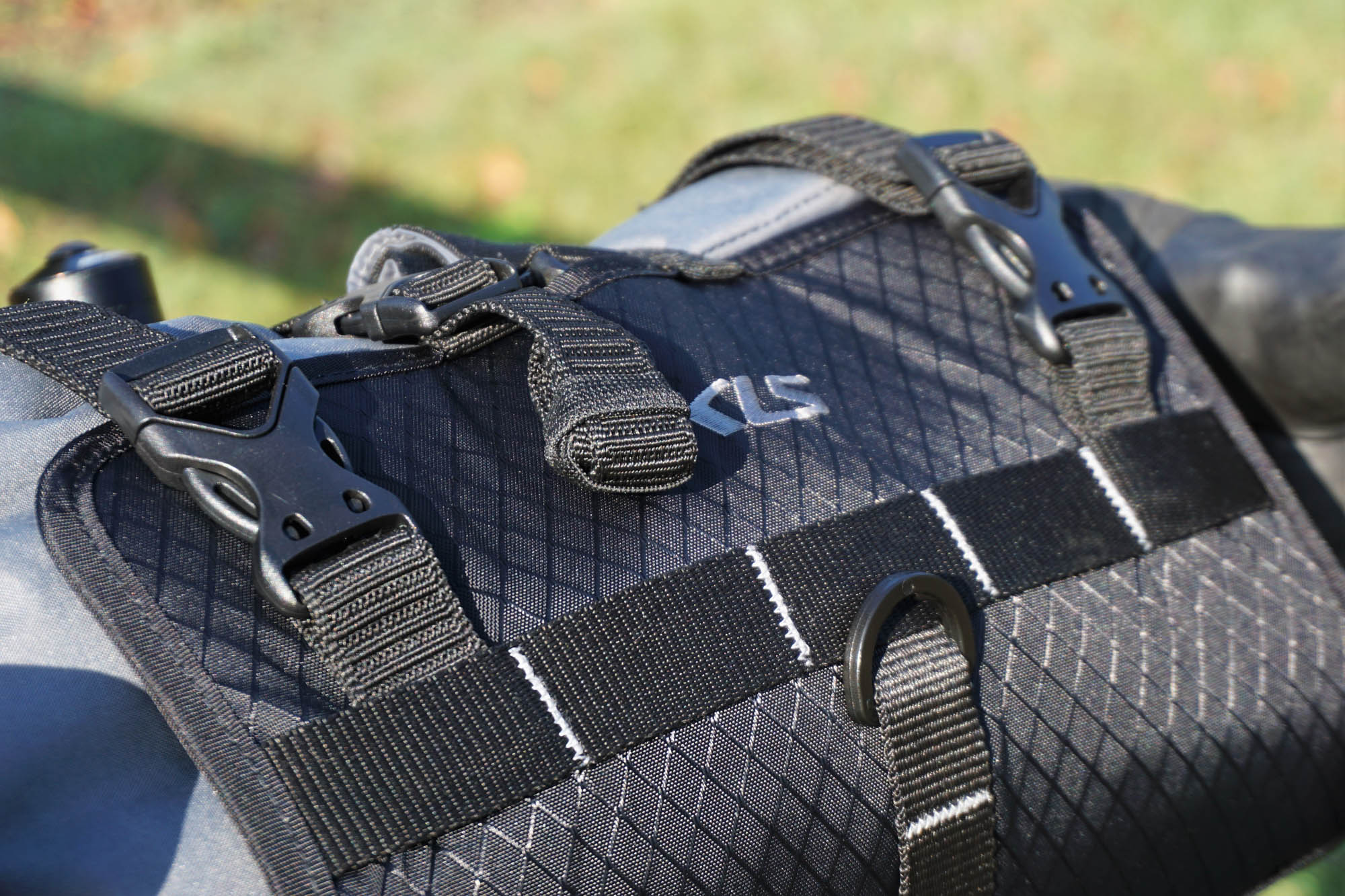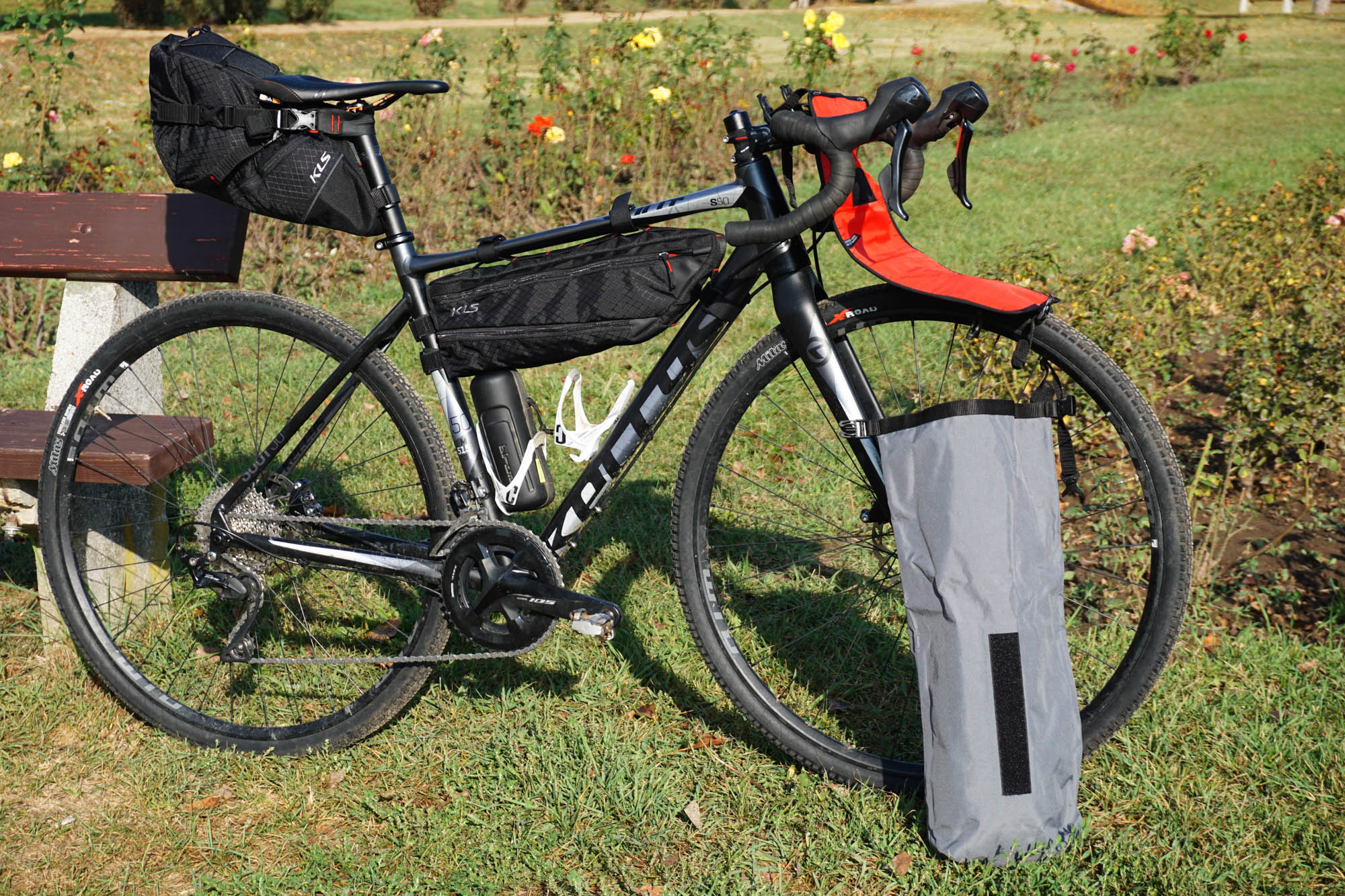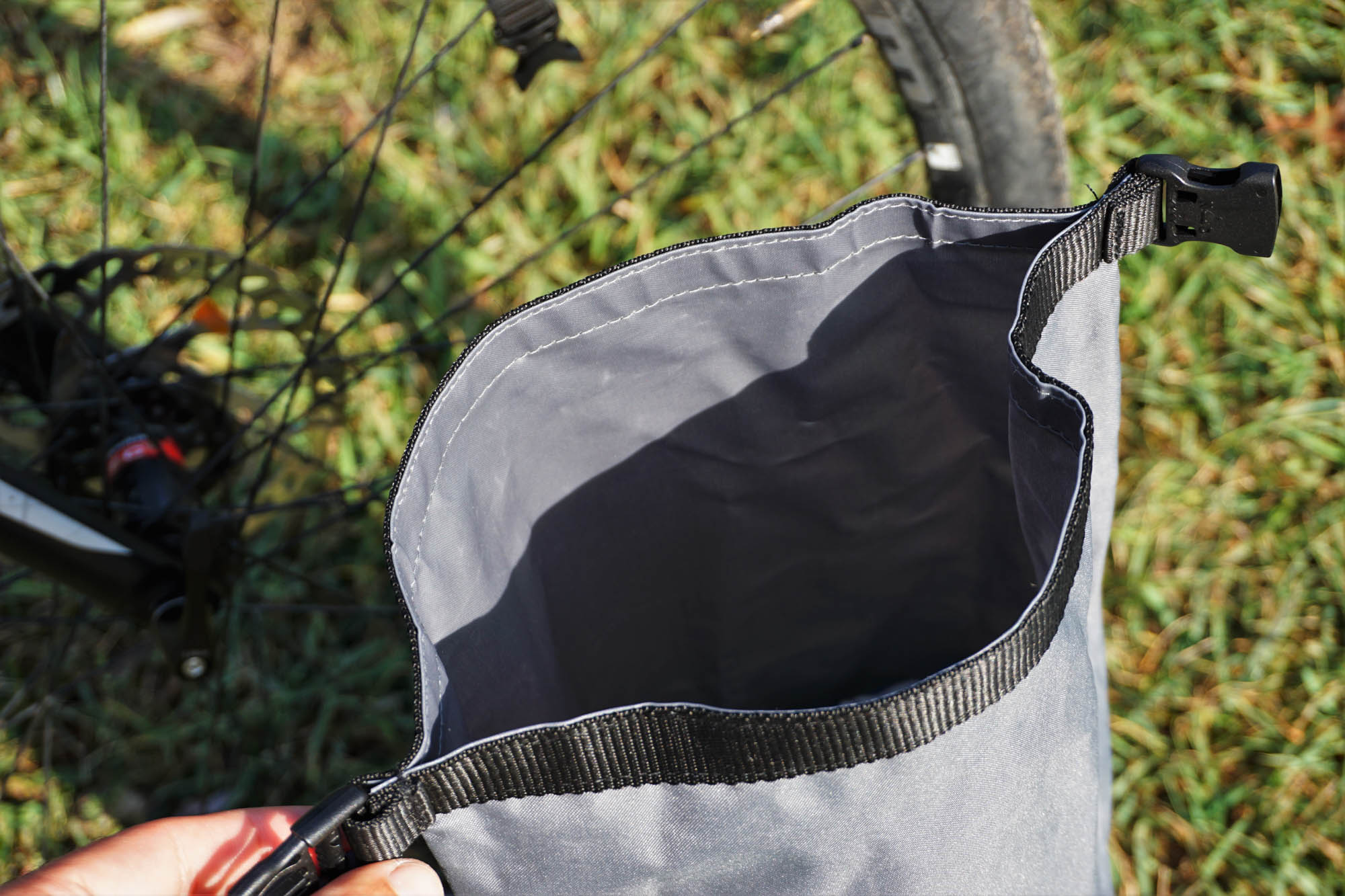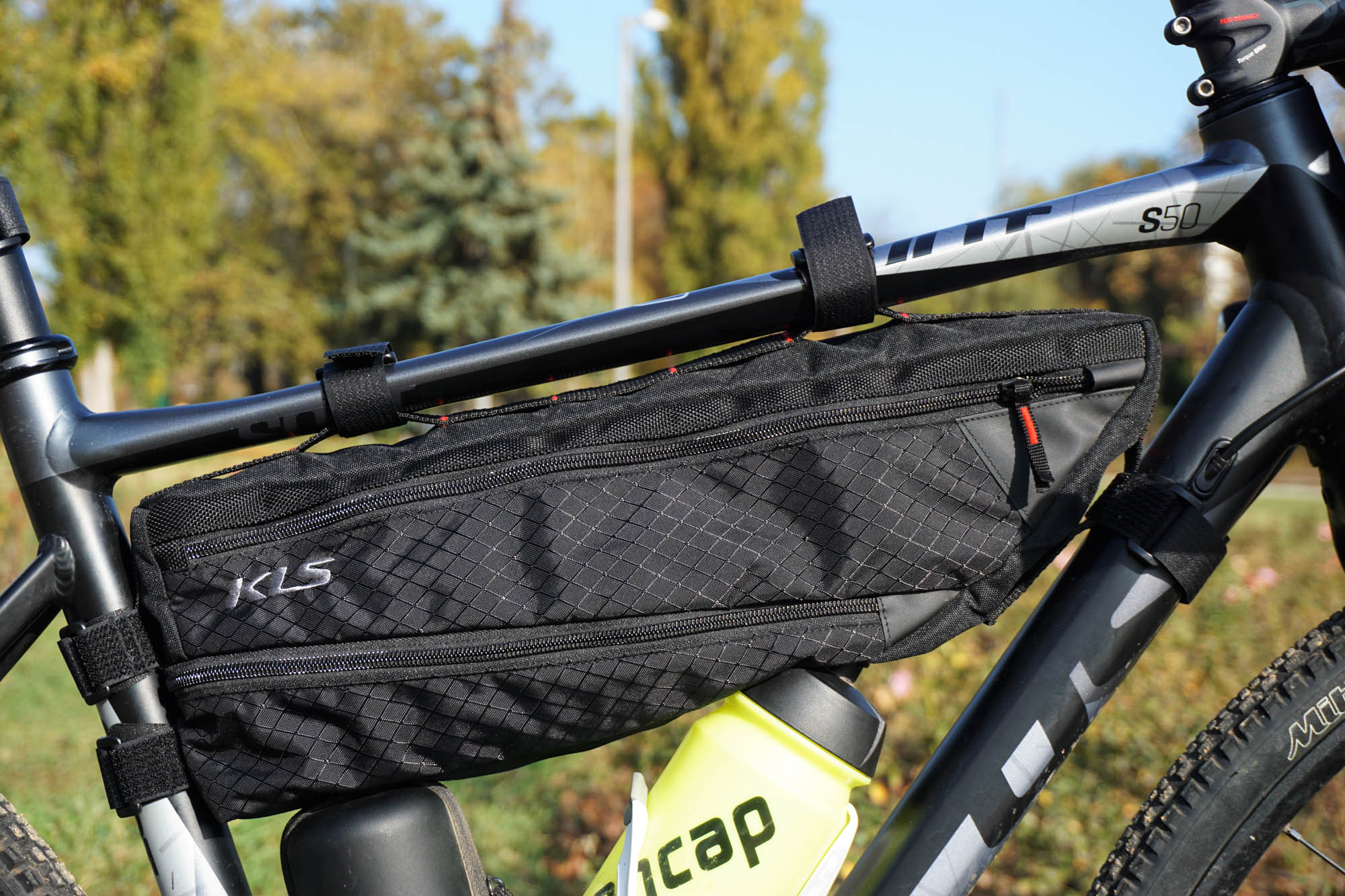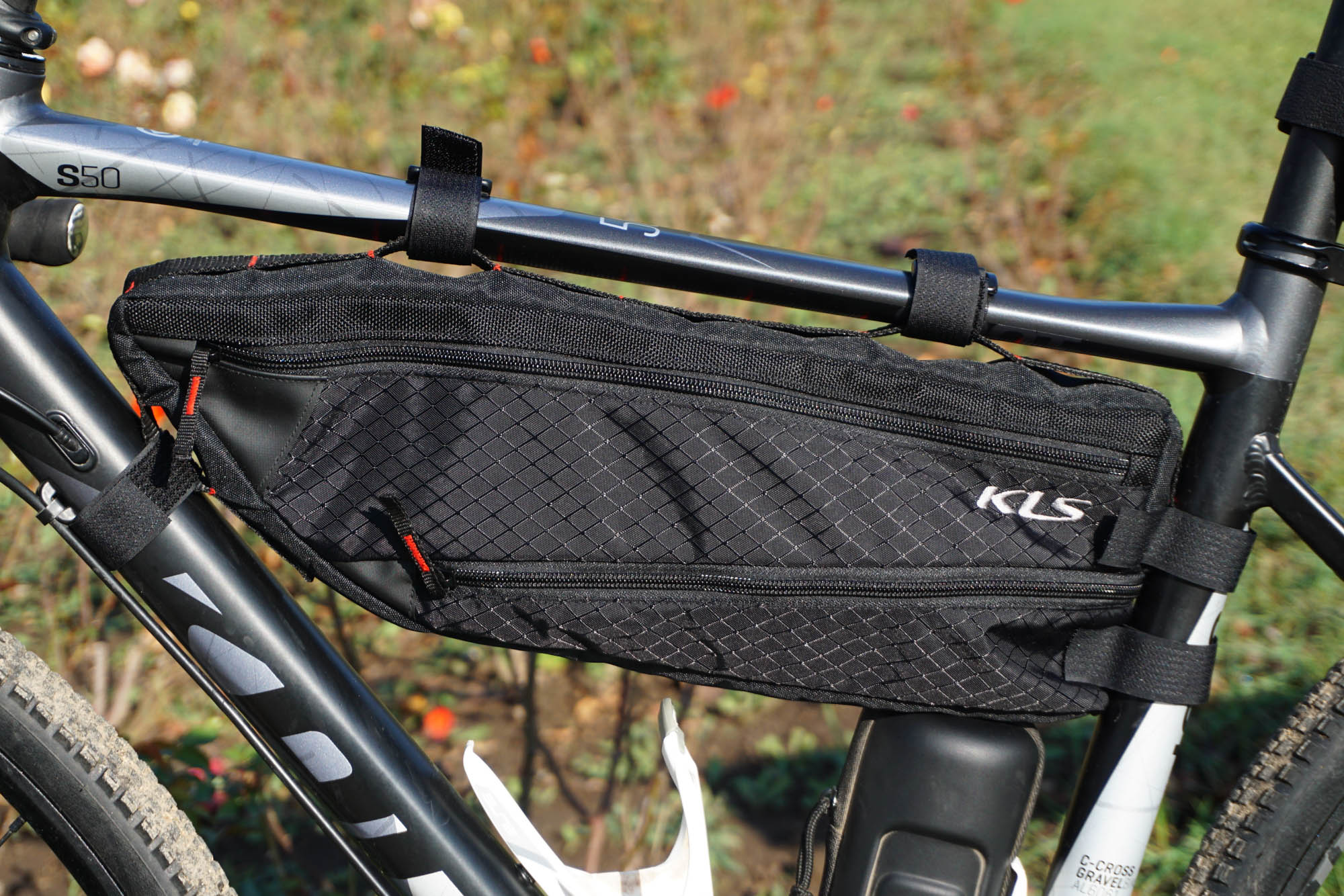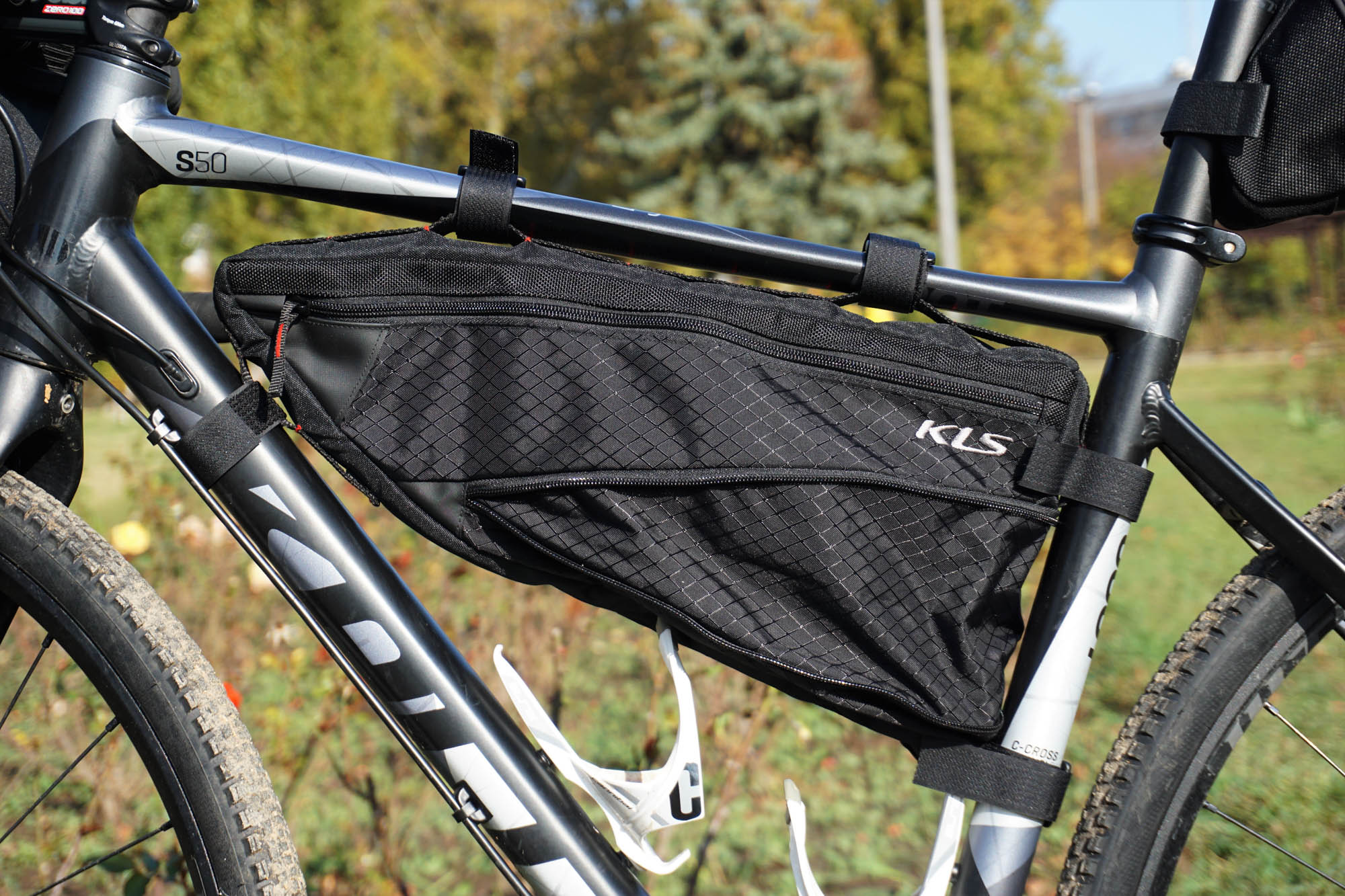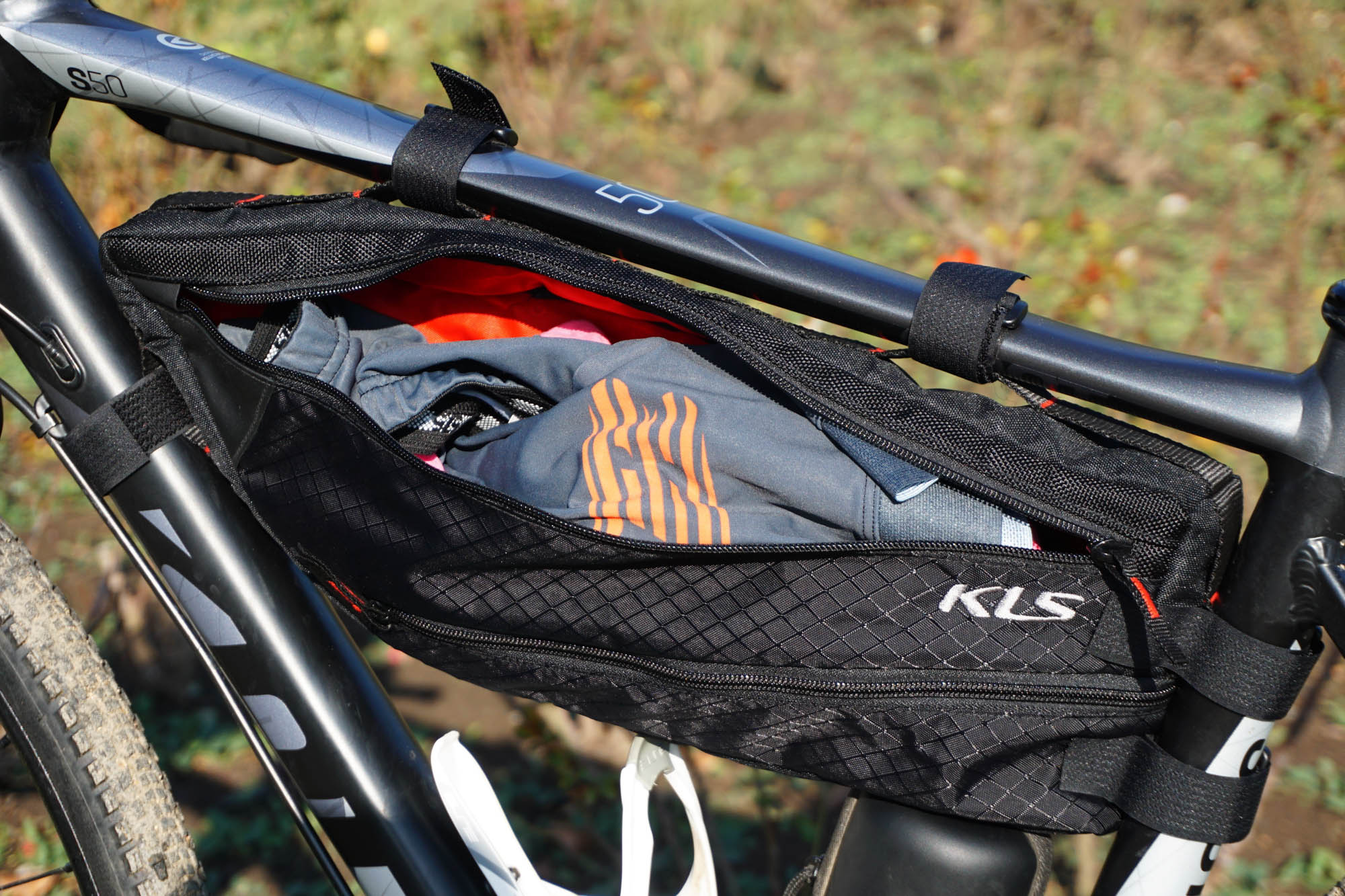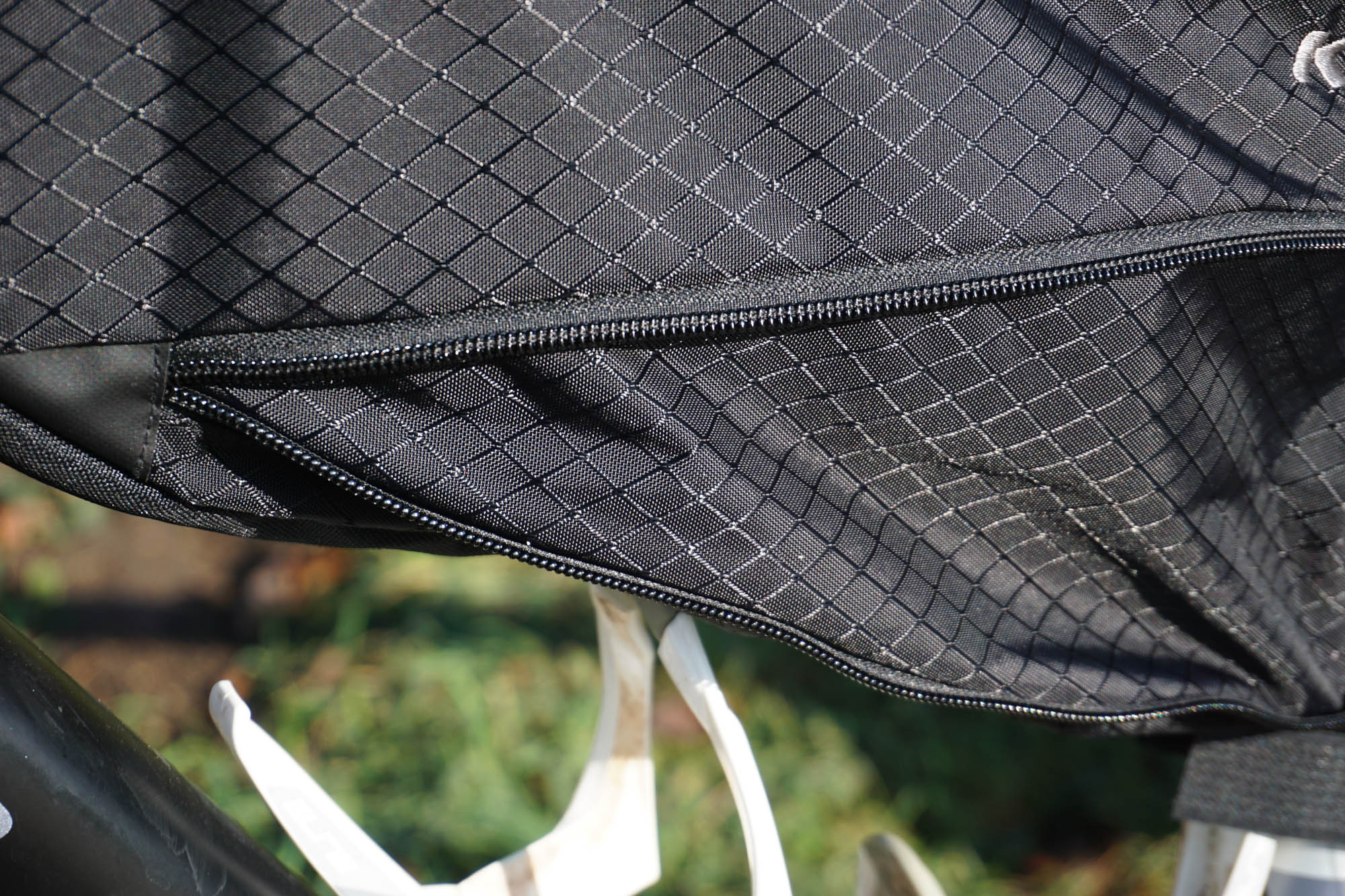These days cycle touring is gaining popularity one again, but with a different flavor called bikepacking. Several brands started offering practical gear and accessories for single or multi-day off-road adventure riding. Kellys is never the one to miss an opportunity to gratify the tangible needs of cyclists, hence the brand launched a complete set of bikepacking bags especially designed for this modern form of bike touring. I received three items from the KLS collection to try and review, comprising of a large saddle bag called the Tanaya, the handlebar-mounted Aura and the Maya which fits inside the bike frame.
The last few years saw the propagation of bikes designed for long-distance adventure riding, likewise many practical accessories have been introduced to make the off-road bike touring experience more enjoyable. It’s debatable whether the wide-spread adoption of gravel bikes lead to the popularity of bikepacking, or the increased demand for adventure in the backwoods brought about the development of the new trend in bike technology: it makes no difference as the so-called gravel bikes and gear are undoubtedly here to stay. Now the market is doing well to cater for the demand, making it easy for riders to set out for multi-day escapades on board bikes that are capable of tackling unpaved roads and carrying all the necessary gear.
In the past all cyclists used to install a rear luggage rack onto which they attached panniers or touring bags when setting out on shorter or longer bike adventures. This setup was mainly down to availability, however it’s not be the most suitable for riding into the wilderness. Generally rear loading of the bike alters the weight distribution and handling of the bike. Overloading the rear wheel might not be a major problem on pavement, but by venturing off-road small difficulties are magnified.
Another consideration when choosing a bike touring setup is wind resistance. Drag tends to be much more profound with rear-mounted bags as opposed to ones installed behind the rider or inside the frame tubes. The only advantage of rack-mounted bags is the larger capacity, so for the longest journeys – when you literary have to carry your complete household – they still win hands down. Evidently the bikepacking gear from Kellys found does as much as it can to increase the load capacity: in fact when all three items in this test are considered, the set can hold as much as a rear-mounted bag with 20 liter capacity.
I received this bikepacking bags to complement my Kellys Soot 50 gravel bike, which I have reviewed previously on these pages. I suggest taking a look at the models one by one.
Kellys KLS Tanaya saddle bag
This bag may seem overly large when mount behind the saddle of the bike, but I can assure you that the KLS Tanaya does in fact fit, it doesn’t hamper leg movement and stays in place despite the large backward extension. Mounting the bag took some time as evidently I’m lacking experience when it comes to bikepacking gear. After a couple minutes I discovered how the bag needs to be installed. I should have consulted the included user manual beforehand, but as you know, we men generally presume that we know everything instinctively So save yourself those minutes, it’s not overly complicated, and one you understand the logic behind it, mounting and removing the Tanaya will become a routine procedure.
The three attachment points are at the seat post, the saddle rails and at the post clamp mechanism where these two components join. To make mounting as stable as possible, Kellys employed tree straps coming from three different angles. This is not superfluous as the Tanaya has a 7 liter capacity, so it could become quite heavy, posing problems when venturing off-road. It’s advisable to start the mounting procedure by running the appropriate strap behind the saddle rails, then continue by fastening the other strap to the seat post. This is essentially how you would attach any other saddle bags to the bike. The next step is to run the third strap around the seat clamp. Once all the attachments are made, you should tighten each of the straps, then fasten them with the buckles.
At this point the KLS Tanaya seat bag can finally be packed. Although the capacity on paper is only 7 liters, I can assure you that it can swallow a lot of stuff. For my first ride I decided to try its limits by stuffing my winter jacket into the Tanaya. Well it not only fit nicely, but left some room for more things. Ok, so I packed my base layer on top of it and there was still more room to work with. Essentially a complete change of cycling clothes was absorbed when I decided to shut the bag. Closing is done using Velcro straps, then the strip is fastened with a buckle to the seat clamp strap. Then all the straps should be tightened to prevent unwanted bag movement during the ride. If there is some leftover strap, it should to be folded up and joined by the supplied rubber flap. This serves to keep everything tidy and avoid the strap becoming ensnared.
Once the main compartment is filled up, the rider still has the option of packing smaller items into the zippered side pockets. If there is even more stuff to pack, the KLS Tanaya has rubber straps at the top to keep some items attached. Since these objects are outside the bag, they won’t be protected like the stuff hidden inside. We should note that the Tanaya is made from waterproof material, but it’s generally good practice to put all items into thin nylon bags before packing them away. This way they’ll be able survive even a large downpour.
The Tanaya is surprisingly stable in practice, it has no tendency to shift side to side or move about like other large seat bags often do. Likewise my worries about scraping the bag with by tights were totally unfounded. The straps also stayed in place, and didn’t loosen during any of my rides. This was true for both on and off road riding, which I think is quite remarkable! The secret I think is the use of a special ribbed material for the straps, so Kellys has clearly done the homework before setting out to design this bikepacking collection!
It should be noted that the Tanaya is most stable when it’s packed. There are quite a few reinforcements within the bag, and the straps are perfectly positioned, nevertheless its shape is not ideal when empty. This is something to consider, but it’s generally true for seat bags, so it’s not really a deficiency for this model.
Recommended retail price: HUF 14,990.
KLS Aura handlebar bag
Handlebar bags are way simpler regarding their construction and attachment. On paper the Aura has 9 liter of capacity, and it’s fixed to the handlebar using two straps on each side. This is as simple bikepacking equipment go, so it takes virtually no time to put one on or remove. Despite its simplicity, the Aura is very stable while out riding, which is partly down to the wrap-around fastening system. We also get foam protectors with the Aura to avoid abrasion to the cabling, but on my setup these were not needed. The only difficulty I encountered while using this handlebar bag was interference with the Garmin mount. On my bike this extends forward in front of the stem, so it had to be removed, and I needed to resort the stem mount option for my beloved computer.
The Aura actually consists of an open ended sack which the rider stuffs with whatever fits into it. The package is then attached to the top part of the outer shell via two buckles. At that point the bag needs to be rolled up and joined by two large and secure buckles. This package then can be fastened to the handlebar and/or the head tube using the strap system. If everything is carried out according to the instructions, the Aura will stay put, and never move up or down even when riding in challenging off-road conditions. Similar to the Tanaya, this bag is water-resistant, but not completely waterproof.
Thanks to its fold-up construction packing into the Aura is a piece of cake. Just like with the Tanaya I was surprised how much stuff it’s able to swallow. This makes the Aura bag ideal for riders who are not very meticulous in how they pack up their gear – those wanting to get things done as quickly as possible. Consequently there are no separate compartments or pockets on this bag, just a single sack to put everything into. In case some things are left out, they can be attached to the outside using one of the several nibs located on the top of the bag. This may also come handy when you buy something during the journey, and do not want to unpack any of the bags.
Just a note of caution, if the bag gets over packed, it may get in the way of our hands on the bar, possibly compromising handling! This problem may only arise in case of narrow bars, but it’s something the rider has to pay attention to. The accompanying pictures show that the Aura is about the largest handlebar bag I could fit in my setup.
All in all, the KLS Aura is a fine bikepacking accessory. It’s easy to use and practical. If you heed the caveats in the previous paragraph, you’ll have no trouble exploiting its potentials. Nonetheless, you’ll still have to take into the consideration the fact that anything mounted to handlebar will have an effect the bike’s handling. The more the bag weights, the greater the impact. So it’s advisable to put lighter gear in the Aura, things that occupy a large volume but not weight much.
Recommended retail price: HUF 11,990.
KLS Maya frame bag
Frame bags on bikes have always been a contentious topic. On one hand they are the most aerodynamic way to carry a load, on the other hand they usually make accessing water bottles difficult, and smaller frame sizes or unusual designs may not even be able accommodate the given frame bag model. Since frames do differ in how much room they offer inside the main triangle, fitting is generally a trial and error affair.
To alleviate these problems, Kellys offers several frame bag models of different size. The KLS Maya is the largest of all, it offers 2.8 liter capacity which can be extended to 3.8 liter if the lower section is opened. The extension is opened using a zipper, and allows more stuff to be packed into the lower part of the bag.
Attaching the Maya to the frame is a very easy affair: it’s simply fixed by five wide Velcro straps. The bands are long enough to embrace even the fattest carbon frame tubes, but for most bikes they‘ll likely be too long. I think it’s a good idea to trim the leftover to tidy both the appearance and avoid accidental opening with the rider’s legs. The bag has two compartments which make packing more organized. The top one is the larger, and the lower is actually an extension, which increases the capacity by 1 liter when unzipped. The inside of the bag has red lining which I found makes finding stuff easier.
On my “M” size Kellys Soot frame the Maya just about leaves enough room for two small water bottles. Getting them in and out is slightly hampered, but doable. If I unzip the lower compartment, the bottles cannot be used at all. Moving the cage installed on the down tube lower would at least leave room for one small bottle, but for most riders it may not be worth the trouble. So one has to weigh the advantage of the additional 1 liter capacity against the drawback of losing the use of both the cages. Tall riders with larger bike frames may get away with using the extension, but access to one bottle may still be blocked.
I was never the fan of frame bags, and the Maya didn’t really change my opinion on this contentious topic. Apart from the problem of with the bottles, I also had to put up with leg interference: i.e. when shifting my weight to either side. Since off-road riding involves a lot of side to side motion in order to balance the bike, this proved to be even more of a deal-breaker. Although it may be less of a concern for those who pedal with knees out, I feel a frame mounted bag like the Maya entails too much compromise, from finding the right size to compromising ergonomics and practicality.
Recommended retail price: HUF 9990.


